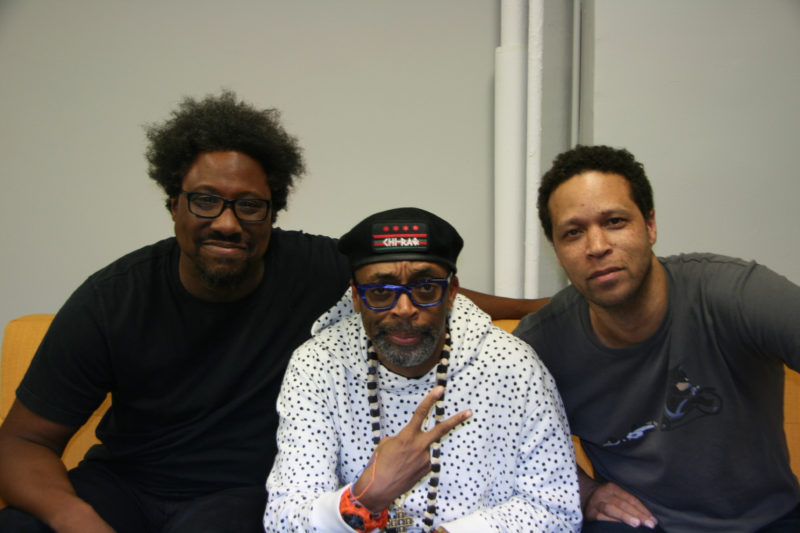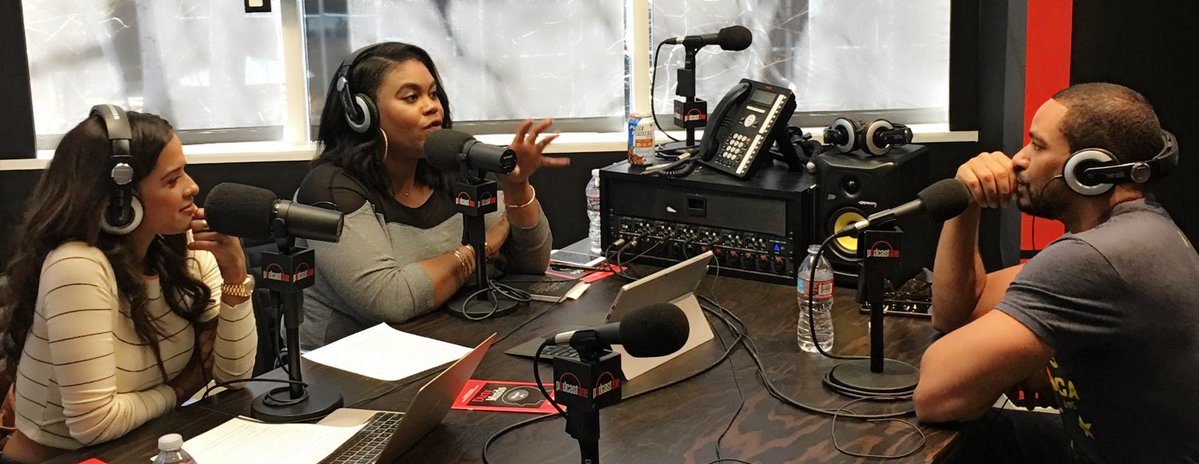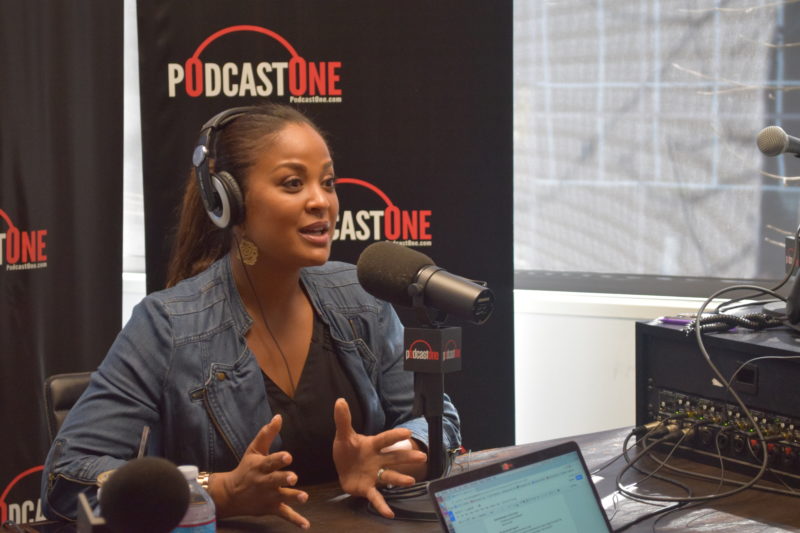Within the first three minutes of the premiere of the podcast Little Black Dress, entertainment journalist Nina Parker laid out the show’s mission: “There’s definitely a lot of podcasts with women, but there’s not a ton of podcasts with some who look like us. Nothing against the other podcasts, but we just wanted to represent a perspective that is a bit null and void.”
Her co-host, Rocsi Diaz, then put a finer point on it: “The brown perspective, OK?”
The two veteran entertainment journalists, in fact, turned to podcasting last month as an outlet for discussion of certain corners of pop culture that they’d had difficulty getting to cover in their mainstream media day jobs. Diaz, who hosts Dating Naked on VH1 and is a former Entertainment Tonight correspondent; and Parker, who had stints at TMZ and The Insider before landing as an Access Hollywood Live host, felt stifled as they tried to persuade bosses and colleagues to cover people of color who aren’t already, as Parker puts it, “A-list superstars.”
In joining the podosphere, though, they quickly realized the new medium, for all its openness, still presents barriers to hosts of color and their relevant subject matter. It’s certainly true that anyone can make and publish a show, the women learned, but earning attention from iTunes—the most powerful gatekeeper in the space—can be mysterious and difficult. Indeed, the process may be opaque, but the results are clear: The iTunes Top 100 chart is dominated by shows featuring white hosts even as research shows the share of the podcast audience comprised of non-white listeners is growing fast.
RELATED: 10 great podcasts to diversify your listening lineup
On March 6, for instance, just five shows featured any African-American hosts—highest-ranked was astrophysicist Neil DeGrasse Tyson’s StarTalk at No. 45. Five other shows featured non-white hosts, including Hidden Brain, an NPR program with Shankar Vedantum, who is Indian-American, that ranked No. 25. While rankings shift frequently, sometimes more than once a day, about 70 percent of the top 100 shows have remained in that stratum for the past two weeks.
The power vested in iTunes and its charts are considerable and, evidently, subject to a weighting scheme adjusted by Apple programmers. Apple did not comment for this article—an iTunes publicist set up a time to speak with CJR, but then did not call at the appointed time and did not respond to subsequent emails—but several podcast industry experts we interviewed say the rankings are not a straightforward listing of the most-downloaded programs.
“It has something to do with the rate of subscriptions, so newness plays a big factor in it because sometimes things have been in the top 10 for weeks, and later it turns out they had very few downloads in the end,” says Anya Grundmann, vice president for programming at National Public Radio. “We’re not sure how iTunes does it, but it’s not a pure volume indicator.”
Today the #LBDpodcast launches! Our 1st guest is @Aminabuddafly! Listen 4 FREE here https://t.co/WxgzpmhEym or here: https://t.co/GEbyXhXBHm pic.twitter.com/e1gmFJ7RSz
— Nina Parker (@MzGossipGirl) February 23, 2017
Still, it is universally agreed that those rankings and iTunes’s podcasting homepage are the starting point for most listeners looking for programs that interest them. And in that respect, host Lauren Ober of The Big Listen—a show about podcasts that’s broadcast on the public radio station WAMU in Washington, DC—says iTunes’s selections for promotion on its podcasting store’s front page have an Oprah’s Book Club-like impact on a show’s popularity.
“So just look at the ones that are in the top promos,” Ober says, scrolling through the largest set of show banners from March 10. “There’s Reveal, which is actually hosted by an African-American man. There’s The Chase Jarvis Show, I’ve never heard of that person, but it’s a white lady. The Journal by Kevin Rose, that’s a white dude who’s in the picture. Another white person is in the Secrets, Crimes and Audiotape art, and then That’s So Retrograde, two white ladies. Entertainment Weekly Binge, and it’s Friday Night Lights, and it’s all pictures of white ladies. And then Matt & Doree’s Eggscellent Adventure, and it’s a white couple, and Lore, hosted by a white dude. Take that for what it is.” (The Binge promotional art, in fact, actually also featured African-American actor Michael B. Jordan.)
What’s driving the overwhelming podcast whiteness is, of course, difficult to say without an explanation from Apple. Lower down on iTunes’s front page is a section called “Featured Collections” that batches together specific niche shows. One icon, which last week required a lot of scrolling and searching, is “The Black Experience,” which leads to a grouping of 50 shows by African-Americans and about race-related topics, curated for Black History Month.
Ober, who tries to boost the less-noticed programs on featuring minorities and minority issues on her show, believes iTunes’s sins are technological as well as a failure of its staff to take interest and promote these shows. The iTunes store is primarily a depot for selling music, audio books, movies, and TV programs, so little effort is put into making an effective search function for podcasts—which are free and only make Apple money to the extent that people buy Apple devices to consume them.
“Discovery mechanisms for podcasts are new and, while some are in the works right now, we don’t have a great system to find shows that are of a particular interest,” Ober says. “I can’t search on iTunes for ‘black podcasts’ because that’s not going to get me a list of anything useful. I can’t search ‘women’s history’ in podcasts, because I’m not going to get anything unless ‘women’ or ‘history’ are in the title. The search thing is problematic.”
Ober is not the only one trying to bring attention to lesser-noticed shows by minorities. Berry Sykes, a Denver-based call center employee, launched PodcastsinColor.com in 2015 primarily to promote a few programs she liked, including The Read, a hugely popular comedy and pop-culture podcast produced and hosted by a pair of African-American friends. Soon she found herself the manager of the non-white podcasting world’s main portal, now with more than 300 active shows and a Twitter hashtag, #Podsincolor, that enables podcast creators to tell her and others about new programs and episodes.
This week on #TheRead: Beyoncé trolls us, Nicki still lost and Trump stays pissed. https://t.co/uwTNQ8yrd2 https://t.co/AcFykZfP6k
— The Read (@ThisIsTheRead) March 16, 2017
“I didn’t think there were actually that many podcasts of color out there, so the fact that I get new submissions every day is crazy to me,” says Sykes, who now also has a part-time gig as social media director for Loud Speakers, a podcast network that caters to diverse material and audiences. “There’s a lot of amazing talent out there. In the next year or so, we’re going to see a boom in the professionalism and what podcasters of color think they can do.”
Sykes is less critical of Apple, which she says has been reaching out to minority podcasters in recent months, and more bothered by what some major podcast providers are doing in this space. In most cases, Sykes says, they “have maybe one or two black shows,” and those opportunities only go to people of color with pre-existing media profiles.
“You’ll see podcasts with normal white guys from regular backgrounds all over the place, but when you’re getting a black podcast on a network, it’s somebody from the world of entertainment or sports and YouTube or something like that,” she says. “It’s always about the powers that be and what they’re familiar with. And they’re white.”
To wit, HowStuffWorks and Gimlet networks, both of which populate iTunes’s charts with multiple shows, have no hosts of color on any of their programs. Other popular programs, including Serial and 99 Percent Invisible, appear to have no black or Hispanic editorial staffers at all based on staff listings and social media profiles.
Panoply, which produces podcasts for Slate, The Wall Street Journal, and New York magazine, came under fire recently after unceremoniously canceling a two-year-old program called Our National Conversation About Conversations About Race just weeks into the Trump era and on the eve of Black History Month.
Panoply still hosts several diverse shows, including BuzzFeed’s African-American pop-culture chat show Another Round and See Something Say Something, which features a diverse quintet of Muslim hosts. But Jezebel founder Anna Holmes, one of the four co-hosts of the canceled show, says Panoply offered no indication of its dissatisfaction or advice on improving the program.
Saw Get Out tonight. @JordanPeele is brilliant ?? definitely recommend it & @anotherround episode on film! https://t.co/Ba7fYOt9Oa
— Carla (@BilingualEd_CE) March 20, 2017
“It was not lost on anybody that there aren’t a lot of podcasts that deal with issues of race,” Holmes says. “Most podcast networks and producers are white, as are the large majority of the media, and the fact is a lot of white people don’t want to talk about race. It makes them uncomfortable. Producing a show like that is going to be difficult for them because they don’t know how to talk about race. This is an issue that goes back to public radio in general, which is an incredibly white medium.”
In a statement appended to the top of the show’s site, the network says it pulled the plug because of “frequent scheduling issues” and that killing it was “one of the hardest (decisions). Now more than ever, Panoply recognizes the urgent need for diverse voices and frank conversions, and we’re committed to covering the important topics of race and ethnicity in America.”
Attempts to reach Panoply by email were unsuccessful, and no phone number could be located. Last week, the network Earwolf announced it will be the new home of the coming second season of Politically Re-Active, a show launched last year on Panoply and co-hosted by W. Kamau Bell, who is black, and Hari Kondabolu, who is Indian-American. Neither Panoply nor the show’s hosts have explained why they left Panoply, but Bell already hosts another show on Earwolf’s roster.
Holmes’s remarks point to perhaps the one entity most capable of diversifying iTunes’s charts: public radio. Twenty-three of the Top 100 on March 6 were created or distributed by taxpayer-supported noncommercial radio entities, primarily NPR and its affiliates. From long-running broadcast hits repurposed as podcasts—Science Friday, Fresh Air, On The Media, and This American Life among them—to online-specific programs like Freakonomics, Planet Money, and Invisibilia, most of the ranked podcasts from public radio outlets feature only white hosts and contributors.
NPR brass insist they’re addressing the issue. They point to Hidden Brain with Shankar Vedantam, which was ranked No. 25 on March 6, as well as Code Switch, a podcast specifically about racial matters, which was No. 97. While NPR’s No. 16-ranked Politics Podcast, a rotating panel of NPR reporters discussing the week’s news, has not featured any non-white voices for more than three months, that’s because the former co-hosts, Sam Sanders, who is black, and Asma Khalid, who is of Middle Eastern descent, have moved on since the election to other assignments, says Grundmann, the NPR vice president.
The network views the podcast space as its opportunity to introduce fresh voices, give new talent more experience, and try different formats. It’s also no accident that a ubiquitous Web advertisement for the NPR One smartphone app features a smiling black woman with the tag: “News. Podcasts. Hand-picked stories.”
“Our future as an organization will involve a great deal of the work we’re doing in podcasting and the ability to speak to larger and more diverse audiences hinges on our ability to find that talent,” says Keith Woods, NPR’s vice president for diversity in news, who is black. “This is NPR’s effort to grow talent base from stories up to shows in the pipeline we’re trying to build.”
Sick of fighting over Uno at family gatherings? Try arguing about who’s blackest. (@AskLeezul) https://t.co/Bz0Q7lqSdc
— NPR’s Code Switch (@NPRCodeSwitch) March 17, 2017
Part of the problem for both NPR and the podcast world writ large is how quickly the podcast industry emerged and how suddenly there was a demand for producers of audio content. Until that time, jobs in audio production were “few and far between, they were low-paying, and they were scattered across the country,” says Chris Bannon, chief content officer for Midroll Media, a E.W. Scripps subsidiary that produces the Earwolf network of podcasts.
“Until very recently, it was not a highly desirable place to go for most people to look for work and there was not very much training of any kind at any college anywhere,” says Bannon, former vice president for content development and production for WNYC Radio. “They were just broadcast jobs like any other and they weren’t particularly sexy. When you can finally get ProTools and build a studio at home, that unleashed a lot of power and interest.”

Hosts W. Kamau Bell and Kevin Avery of the podcast ‘Denzel Washington is the Greatest Actor Of All Time,’ from Earwolf, pose with Spike Lee.
The advantage in that moment went to people who had been acquiring skills as producers at public radio stations, the vast majority of whom were—and are—white. And that has had an impact on what’s out there, says Clemson media studies professor Chenjerai Kumanyika, whose 2015 essay on “the whiteness of public radio” homed in on this question.
“There are a lot of aspiring podcasters, but the ones who are able to do it are the people who have operated as interns and who can afford to pay money for these expensive workshops,” Kumanyika says. “People who often wind up being able to produce a story that’s good enough to get on one of these popular podcasts are also people who have done it many times before because they were interns at a public media place, right?”
Kumanyika has endured in the podcast space a similar issue to what Parker and Diaz experienced in pitching diverse stories in their newsrooms: White gatekeepers.
It’s always about the powers that be and what they’re familiar with. And they’re white.
“There’s a certain set of tastemakers,” he says. “If I want to get my story onto one of these really popular podcasts, it’s going to have to go through editors at Gimlet or editors at NPR or editors at Invisibilia. I’ve worked with all these people and had good experiences, but I’ve also been conscious that it wasn’t easy getting the story through there, and I was inevitably going through white people.”
One large podcast network making a concerted effort is PodcastOne, created and run by Westwood One founder Norm Pattiz. PodcastOne boasts more than 200 shows including Little Black Dress, Black Sports Weekly, and shows featuring Shaquille O’Neal and Laila Ali. To Pattiz, the lack of diversity in iTunes’s charts and on many of NPR’s most popular shows presents a significant business opportunity. According to Edison Research, African-American and Hispanic listeners combined for 28 percent of the overall podcast audience in 2016, up from 25 percent in 2011, while white listeners now make up 63 percent of the overall audience, down from 68 percent.”
“We target those audiences because there are sources of revenue looking to reach them,” Pattiz says. “We know that less than 40 percent of Americans have ever consumed a podcast, but that audience has been pretty much lily white. The good news is more than 60 percent haven’t, and that includes communities of color.”
Parker and Diaz, who launched Little Black Dress in late February, are encouraged by the response so far. The debut episode, which featured an interview with reality show star Amina Buddafly of VH1’s Love & Hip Hop: New York, was downloaded more than 75,000 times, Parker says. That’s an example, she says, of content mainstream outlets have shown little interest in creating.
“I’m fed up with that, and I feel like I’m in a position to where I have all these mainstream connections, but I also have all these connections to black Twitter and the urban world,” Parker says. “For me, it was unacceptable to keep ignoring an audience of people who want information from me and not being able to give it to them because maybe a platform doesn’t see these people as viable for their show.”
Steve Friess is a freelance journalist based in Ann Arbor and a journalism instructor at Michigan State University. Follow him at @SteveFriess.


